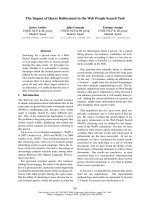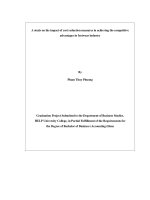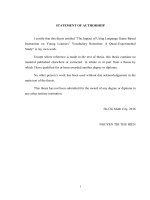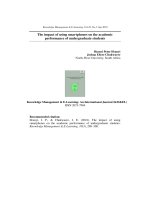The impact of using text shadowing in developing efl primary school students speaking skills in an nhon town
Bạn đang xem bản rút gọn của tài liệu. Xem và tải ngay bản đầy đủ của tài liệu tại đây (1.31 MB, 92 trang )
MINISTRY OF EDUCATION AND TRAINING
QUY NHON UNIVERSITY
VO THI KIM NGAN
THE IMPACT OF USING TEXT SHADOWING IN
DEVELOPING EFL PRIMARY SCHOOL STUDENTS’
SPEAKING SKILLS IN AN NHON TOWN
Field : Theory and Methodology of English Language Teaching
Code : 8140111
Supervisor: NGUYEN TIEN PHUNG, Ph.D
BỘ GIÁO DỤC VÀ ĐÀO TẠO
TRƯỜNG ĐẠI HỌC QUY NHƠN
VÕ THỊ KIM NGÂN
TÁC ĐỘNG CỦA VIỆC SỬ DỤNG KỸ THUẬT NGHE
VÀ NHẮC LẠI ĐỒNG THỜI TRONG PHÁT TRIỂN
KỸ NĂNG NÓI CỦA HỌC SINH TIỂU HỌC
TẠI THỊ XÃ AN NHƠN
Ngành : Lý Luận và Phương Pháp dạy học bộ môn Tiếng Anh
Mã số : 8140111
Người hướng dẫn: TS. Nguyễn Tiến Phùng
i
STATEMENT OF AUTHORSHIP
I confirm that the thesis conducted for my Master of Art degree, titled "THE
IMPACT OF USING TEXT SHADOWING IN DEVELOPING EFL
PRIMARY SCHOOL STUDENTS’ SPEAKING SKILLS IN AN NHON
TOWN", is solely my own work under the supervision of Dr. Nguyen Tien Phung,
a lecturer working at Quy Nhon University. I have not submitted this thesis for any
other degree at any other educational institution. Furthermore, I can affirm that the
content of this thesis does not include any previously published or authored
material, except where explicitly referenced within the thesis itself.
Author’s signature
Vo Thi Kim Ngan
ii
ACKNOWLEDGEMENT
This research could not have reached its current form without the invaluable
assistance, encouragement, and dedication of numerous individuals who provided
support, believed in me, and motivated me to achieve my ultimate objective. I
would like to express my heartfelt appreciation to all those involved. They have
enriched my knowledge and made my graduate journey a memorable chapter in my
life.
I am profoundly thankful to Dr. Nguyen Tien Phung, my supervisor, for his
steadfast patience, priceless mentorship, and genuine counsel throughout my
educational voyage. His timely and comprehensive feedback, deep understanding,
professional assistance, dedication, and unwavering commitment have served as a
driving force in enabling me to accomplish my research successfully.
Furthermore, I would like to extend my heartfelt gratitude to the educators,
lecturers, and professors at Quy Nhon University for their patient and wholehearted
efforts in imparting valuable knowledge and guidance throughout my academic
journey.
I would like to extend my gratitude to the teachers and pupils at Nhon Hanh
Primary School for their invaluable support and collaboration throughout the
duration of this research endeavor.
My closest friends and coworkers deserve special recognition since their
compassion, sympathy, and support gave me the spiritual fortitude I needed to do
this task.
Last but not least, my parents deserve a special thank you for their guidance,
unwavering love, and support, which have inspired me to pursue my education and
fulfill my dual responsibilities in all facets of my life.
iii
ABSTRACT
Most foreign language learners encounter several difficulties in pronouncing
each word correctly and in speaking the whole sentences or structures fluently. For
the students at Nhon Hanh Primary School, the problem might be serious.
Therefore, the researcher needs to find out a suitable technique to improve students’
speaking skills according to students’ needs and context. Research to date has
focused on the issue mentioned on young learners is lacking. As a result of this, the
research was aimed at investigating whether Text Shadowing has any significant
effects on EFL primary school students’ pronunciation and fluency when speaking
English. The research followed a quasi-experimental method with the participant of
78 EFL 2nd Grade learners in a primary school in An Nhon Town. These
participants were divided into 2 groups: the control group and the experimental
group. There were three research instruments namely two speaking tests,
questionnaire and interview. The findings showed that there was improvement in
speaking performance among the control group and the experimental group after
eight weeks. However, the experimental group gave higher improvement than the
control group in memorizing the initial letter sounds, pronouncing words more
clearly and having better intonation. Besides, the majority of the participants in the
experimental group held positive attitudes toward learning and improving their
pronunciation and fluency by Text Shadowing technique. They all found interest
and confidence in learning and speaking English. The researcher suggests that
further studies in this area should consider a larger sample size to obtain a better
picture of the reality of the effect of Text Shadowing technique on speaking skills.
iv
TABLE OF CONTENTS
STATEMENT OF AUTHORSHIP ............................................................................ i
ACKNOWLEDGEMENT ......................................................................................... ii
ABSTRACT .............................................................................................................. iii
TABLE OF CONTENTS .......................................................................................... iv
LIST OF ABBREVIATIONS .................................................................................. vii
LIST OF TABLES .................................................................................................. viii
LIST OF FIGURES................................................................................................... ix
CHAPTER 1: INTRODUCTION............................................................................1
1.1. RATIONALE ...................................................................................................1
1.2. RESEARCH AIM AND OBJECTIVES ..........................................................3
1.2.1. Research aim .............................................................................................3
1.2.2. Research objectives ...................................................................................3
1.3. RESEARCH QUESTIONS..............................................................................3
1.4. HYPOTHESES ................................................................................................4
1.5. SCOPE OF THE STUDY ................................................................................4
1.6. SIGNIFICANCE OF THE STUDY.................................................................4
1.6.1. Theoretically ..............................................................................................5
1.6.2. Practically..................................................................................................5
1.7. ORGANIZATION OF THE STUDY ..............................................................5
CHAPTER 2: LITERATURE REVIEW................................................................7
2.1. SPEAKING ......................................................................................................7
2.1.1. Definition of Speaking ...............................................................................7
2.1.2. Types of Speaking ......................................................................................8
2.1.3. Components of Speaking............................................................................9
2.1.4. Teaching Speaking...................................................................................10
2.1.5. Problems with speaking activity ..............................................................11
2.1.6. Types of spoken test .................................................................................13
2.2. SHADOWING ...............................................................................................15
v
2.2.1. Definition and function of shadowing .....................................................15
2.2.2. Types of shadowing..................................................................................16
2.2.3. Text Shadowing........................................................................................17
2.2.4. Shadowing effects on foreign language learning ....................................18
2.3. STEPS TO BUILD TEXT SHADOWING ACTIVITY................................19
2.4. PREVIOUS STUDIES...................................................................................20
CHAPTER 3: METHODOLOGY.........................................................................23
3.1. RESEARCH DESIGN ...................................................................................23
3.2. PARTICIPANTS............................................................................................24
3.2.1. Research sites ..........................................................................................24
3.2.2. Teacher ....................................................................................................25
3.2.3. Students....................................................................................................25
3.3. MATERIALS .................................................................................................25
3.4. INSTRUMENTS FOR DATA COLLECTION.............................................26
3.4.1. Read Aloud and Interaction Test .............................................................27
3.4.2. The questionnaire ....................................................................................28
3.4.3. The semi-structured interview .................................................................29
3.5. DATA ANALYSIS ........................................................................................30
3.6. PROCEDURE OF THE STUDY...................................................................31
CHAPTER 4: FINDINGS AND DISCUSSION ...................................................36
4.1. FINDINGS IN RESPONSE TO THE RESEARCH QUESTIONS...............36
4.1.1. The effects of using Text Shadowing in developing EFL primary school
students’ speaking skills (Research Question 1) ................................................36
4.1.1.1. Students’ speaking performance between two groups before the
intervention ..............................................................................................36
4.1.1.2. Students’ speaking performance between two groups after the
intervention ..............................................................................................37
4.1.1.3. Summary of findings ...................................................................40
4.1.2. Students’ attitudes towards teachers’ use of Text Shadowing in
developing speaking skills (Research Question 2) .............................................41
vi
4.1.2.1. Students’ attitudes towards using Text Shadowing in improving
pronunciation ........................................................................................... 41
4.1.2.2. Students’ attitudes towards using Text Shadowing in improving
fluency ......................................................................................................42
4.1.2.3. Students’ attitudes towards the attraction and motivation of the
practice ....................................................................................................44
4.1.2.4. Students’ attitudes towards the content of the practice lessons .45
4.1.2.5. Students’ attitudes towards the amount of time for the practice 45
4.1.2.6. Differences in students’ attitudes towards using Text Shadowing
in improving speaking skills ....................................................................46
4.1.2.7. Students’ understanding of using Text Shadowing in learning
speaking skills – its benefits and challenges ...........................................47
4.1.2.8. Summary of findings ...................................................................52
4.2. DISCUSSION OF KEY FINDINGS IN RESPONSE TO THE RESEARCH
QUESTIONS .........................................................................................................52
4.2.1. The effect of Text Shadowing on students’ speaking performance..........52
4.2.2. Students’ attitude towards using Text Shadowing in improving speaking
performance ........................................................................................................ 54
CHAPTER 5: CONCLUSION...............................................................................57
5.1. SUMMARY OF KEY FINDINGS OF THE STUDY...................................57
5.2. CONTRIBUTIONS AND IMPLICATIONS OF THE STUDY ...................57
5.3. LIMITATIONS ..............................................................................................58
5.4. RECOMMENDATIONS FOR FUTURE RESEARCH................................59
REFERENCES ........................................................................................................60
APPENDICES
vii
LIST OF ABBREVIATIONS
2nd second
EFL English as a Foreign Language
L2 Second Language
viii
LIST OF TABLES
Table 3.1. Background information of the participants ............................................25
Table 3.2. Two speaking tests procedure ..................................................................27
Table 3.3. The Differences between Steps of Teacher-based Technique and Text
Shadowing Technique .............................................................................33
Table 4.1. Students’ speaking performance between the two groups before
intervention ..............................................................................................36
Table 4.2. Mean difference of students’ speaking performance within control
group ........................................................................................................37
Table 4.3. Mean difference of students’ speaking performance within
experimental group ..................................................................................38
Table 4.4. Mean Difference (the gain score) between Experimental and Control
Group .......................................................................................................38
Table 4.5. The Results of the Paired-Samples T Test...............................................40
Table 4.6. Descriptive statistics test on student’s attitudes towards using Text
Shadowing in improving speaking skills.................................................47
Table 4.7. The Results of the Independent-Samples T Test .....................................47
ix
LIST OF FIGURES
Figure 4.1. Summary of participant’s speaking performance before and after the
study ......................................................................................................... 39
Figure 4.2. Aspects of pronunciation that the technique of Text Shadowing
helped to improve ....................................................................................41
Figure 4.3. Aspects of fluency that the technique of Text Shadowing helped to
improve ....................................................................................................43
Figure 4.4. Attraction and motivation of the practice ...............................................44
Figure 4.5. The attitude towards the content of the practice lessons ........................45
Figure 4.6. The attitude to the time delivery for the practice....................................46
1
CHAPTER 1: INTRODUCTION
This chapter provides the rationale for conducting the study and outlines major
components of the thesis. The main reasons for doing this research are outlined,
along with aim, objectives and research questions that are addressed. The chapter
also discusses the scope and significance of the study. Finally, an overview is given
of how this study is structured.
1.1. RATIONALE
During the time teaching English at a primary school in An Nhon Town, Binh
Dinh Province for more than one year, the researcher found that the children face
several difficulties in pronouncing each word correctly and in remembering the
whole sentences or structures. They cannot distinguish how to pronounce one word
with another. Moreover, when they are individually asked to answer the previously
learned structures aloud in front of the class, some of their voices are too faint to be
heard or they cannot answer the questions. Meanwhile, few individuals have the
courage to answer aloud voluntarily. These facts altogether suggest that many of
these young learners might believe that they do not have the aptitude to learn
English, and therefore they lack confidence in speaking that language. This
statement is supported by Lin’s study (2009) reporting that some of her native
Taiwanese junior high school students who were reticent to speak English because
they hardly spoke English inside or outside of class thought that their pronunciation
is poor, and hence they are reluctant to speak. Such perspectives are also consistent
with the researcher’s English teaching and learning experiences in An Nhon Town.
Therefore, in order to improve the researcher’s primary school students’
speaking ability and to empower their confidence, teacher needs to find a suitable
technique to improve students’ speaking performance according to students’ needs
and context. There are many techniques to improve students’ speaking skills, one of
which is the use of Text Shadowing. It is a simpler variant of shadowing technique
by providing listeners or shadowers with a written text to immediately repeat or
2
simultaneously imitate what is heard. The main difference between Text Shadowing
and shadowing is that the former has text while the latter does not. In previous
studies in the world (Hsieh et al., 2013; Hamada, 2014; Hamzar, 2015; Wahdini,
2015; Leonisa, 2020; Ekayati, 2020; Win, 2020; Anis, 2021), shadowing rather than
Text Shadowing was used to improve college or high school students’
pronunciation, listening, speaking or reading abilities because these learners had
achieved a certain (intermediate or high-intermediate) proficiency level so that they
might not encounter too many difficulties when doing shadowing. Hsieh et al.
(2013) discovered that self-studying and practicing shadowing with My English
Tutor (MyET) enhanced word pronunciation, fluency, and intonation. According to
Hamada (2014), post-shadowing alone increased listening comprehension abilities.
According to the findings of Hamzar’s (2015) study, (1) the use of shadowing
approach increased students’ speaking ability in terms of accuracy, fluency, and
comprehensibility, and (2) the use of shadowing technique inspired students to
speak English. Shadow-reading is more successful than Guided Reading, according
to Wahdini (2015), and children with strong motivation have improved reading
comprehension. Leonisa (2020) concluded that shadowing technique is effective on
students’ pronunciation at the tenth-grade students of SMAN 1 Jetis Ponorogo.
Ekayati’s (2020) research result showed that applying the shadowing technique
influences students’ listening ability in word recognition. Win (2020) concluded
that shadowing is a good strategy for teaching speaking and listening skills because
it helps students recognize stress patterns in speaking. Anis (2021) revealed that
employing shadowing increased the content of 80 eighth-grade pupils by 34.7%.
However, fewer educational specialists in Viet Nam have recently conducted
studies on shadowing technique and its usefulness for foreign language acquisition
in general and skills instruction in particular. Mai (2016) investigated the impact of
shadowing in listening courses and discovered that both instructors’ and students’
attitudes indicate the technique's efficacy. According to Trang (2021), students’
memory, pronunciation, vocabulary, and awareness of growing their word banks, as
well as their listening and pronunciation skills and vocabulary practice are all
3
improved by shadowing on BBC Six-Minute English. This ultimately improves
their speaking and vocabulary skills. Luu (2023) discovered that speaking plus
shadowing improved speaking abilities. Most studies in Vietnam have been
conducted on students at universities (Mai, 2016; Trang, 2021; Luu, 2023). In fact,
to the best of the researcher’s knowledge, no empirical research has been conducted
on EFL primary school learners to examine the effects of Text Shadowing in
developing their speaking skills in Vietnam. The need for such study prompted this
research.
1.2. RESEARCH AIM AND OBJECTIVES
1.2.1. Research aim
The overall aim of this study is to investigate the impact of using Text
Shadowing in developing EFL primary school students’ speaking skills in An Nhon
Town.
1.2.2. Research objectives
In order to achieve this aim, the researcher tried to fulfil the following
objectives:
1. To examine the effects of using Text Shadowing in developing EFL
primary school students’ speaking skills.
2. To gain insights into students’ attitudes towards teachers’ use of Text
Shadowing in developing speaking skills.
1.3. RESEARCH QUESTIONS
In order to measure and evaluate the impact of using Text Shadowing in
developing EFL primary school students’ speaking skills, the following research
questions were proposed:
1. What are the effects of using Text Shadowing technique in developing EFL
primary school students’ speaking skills?
4
2. What are students’ attitudes towards teachers’ use of Text Shadowing in
developing speaking skills?
1.4. HYPOTHESES
The study was based on theories of speaking skills teaching and learning along
with the previous studies on the use of Text Shadowing in teaching and learning
speaking skills. The research suggested the hypotheses of the present study as
follow:
1. (H0) There was no statistically significant difference in speaking
performance between the experimental group and the control group after
the intervention.
2. (H1) The experimental group has a higher level of speaking performance
than the control group after the intervention.
1.5. SCOPE OF THE STUDY
This research focused on recognizing the impact of Text Shadowing in
developing EFL primary school students’ speaking skills. Here are some scopes in
this research:
1. The subject of the research was the second-grade children of Nhon Hanh
Primary School in the 2022/2023 academic years.
2. The object of the research was teaching and learning speaking English
through the Text Shadowing technique.
3. The time of the research was during the second semester in the 2022/2023
academic year.
4. The place of the research was at Nhon Hanh Primary School in An Nhon
Town.
1.6. SIGNIFICANCE OF THE STUDY
After conducting this research, the researcher hopes it has been beneficial as
follows:
5
1.6.1. Theoretically
1. Teaching English to children via Text Shadowing is hoped to engage and
motivate them, which can help improve their speaking skills.
2. By using the Text Shadowing, the teacher is able to access information and
inspiration about an alternate teaching methodology. The teacher can use
this technique in teaching pronunciation as well as intonation.
1.6.2. Practically
1. For teachers
Text Shadowing is expected to be of use for teachers in assisting them
with teaching. It will especially help English teachers at Nhon Hanh Primary
School by providing innovative and creative method for their students. This
can also motivate these educators to maintain a high level of professionalism
while being inventive.
2. For students
It is expected to be useful for students especially for the second-grade
students of Nhon Hanh Primary School in the academic year 2022/2023. It
allows students to practice speaking English, makes their study more active,
enjoyable, and additionally can increase their English speaking skill.
3. For readers
This study is designed to provide a reference for readers who believe
that English speaking skills are important when learning the language.
Motivating them by providing an alternate method of teaching speaking can
encourage these individuals to improve their oral proficiency in English so
that it can be understood by the listener.
1.7. ORGANIZATION OF THE STUDY
The thesis consists of five chapters: Introduction, Literature Review,
Methodology, Findings, Discussion and Conclusion.
6
Chapter one provides the rationale for the study, the aim, the objectives, the
research questions and the hypotheses of the study. Then it presents the scope and
the significance of the study. Finally, it describes the organization of the study.
Chapter two begins by laying out the theoretical dimensions of the research
and looks at definitions of several key terms and important previous studies related
to the current research, followed by an indication of the research gap that the
present study aims to bridge.
Chapter three explains the research method. Firstly, it describes the research
design and the participants of the study. Secondly, it introduces the materials used
for the intervention in detail and the research instruments used to collect data for the
study. Lastly, this chapter will come to an end with the methods of data analysis and
the procedure to conduct the study.
Chapter four gives a detailed presentation and analysis of collected data to
answer the research questions. It begins with the quantitative data analysis of the
tests to address the first research question on the students’ speaking performance
before and after the intervention. Next, the quantitative analyses of the
questionnaire and the qualitative analyses of the face-to-face semi-structured
interviews yields the evidence of the second research question concerning students’
attitudes towards using Text Shadowing in improving speaking skills. Afterwards, it
will interpret these findings and discuss interference to the previous studies.
Chapter five makes a conclusion of the report of the study. First, it will
summarize the main findings of the study. Second, it will suggest the research
implications. Finally, the limitations of the study and the suggestions for future
research will be the last part of this chapter.
7
CHAPTER 2: LITERATURE REVIEW
The purpose of this chapter is to provide a theoretical background for the
thesis by reviewing relevant authoritative studies. The first section of this chapter
defines key terms and provides working definitions, types and functions of those
terms. Following that, the chapter reviews previous studies in relation to this thesis
in order to define the research gap to be achieved.
2.1. SPEAKING
2.1.1. Definition of Speaking
One of the essential skills in English that students must possess is speaking.
Communication is primarily conducted through speaking. Before the researcher
discusses more about speaking, it is better to see some definitions of speaking from
some experts and every expert has different definition given. Speaking is not only
about producing words and sentences; it is a process that involves receiving
messages, processing them, and producing appropriate responses, as mentioned in
Facilitator Guide. Similarly, speaking is a process that involves constructing
meaning that involves producing, receiving, and processing information (Burns and
Joyce, 1997). Speaking in a classroom involves the interaction between teachers and
students or among students that is dependent on the manner in which classroom
activities are conducted.
In the communication process, speaking ability cannot process information
alone, because speaking is not a discrete skill (Hughes and Reed, 2016). One of the
primary challenges in the study of speaking is that it overlaps with other abilities.
Speaking abilities are typically associated with listening abilities. Nunan (2010)
states that listening and speaking are complementary and reciprocal, however, they
utilize different mental processes. In most conversations, we do not simply listen or
speak; we observe and communicate. Byrne (1986) said that speaking or oral
communication involves the two processes of speaker and listener involving
productive and receptive skills. Besides, Cornbleet and Carter (2001, p.18) state that
8
we can attempt a closer definition by saying that speaking is combining sounds in a
recognized and systematic way, according to language-specific principles, to form
meaningful utterances.
In short, speaking can be defined as a means of verbal communication which
allows for the transmission of information between two parties. The speaker is in
charge of conveying information and the listener becomes an active participant by
receiving it for a specific purpose.
2.1.2. Types of Speaking
According to Brown and Abeywickrama (2004), there are some basic types of
speaking as in the following:
1. Imitative: The most basic type of speaking taught to beginners is to imitate
a word or phrase or sentence.
2. Intensive: A style of speaking that focuses on the use of prosody (elements
such as intonation, stress, and rhythm).
3. Responsive: This type teaches how to respond effectively in limited-length
conversations.
4. Interactive: Different from the responsive type, interactive focuses on a
longer conversation in which both speakers and listeners exchange information.
5. Extensive (monologue): Oral production tasks, such as speeches and oral
presentations, often involve interacting with a listener who is not present in an overt
manner. This can be difficult to do when the opportunity for interaction is limited or
nonexistent.
In this study, the researcher will use the first type (imitative), one of the five
types presented by Brown and Abeywickrama, because this study will only focus on
students’ English speaking ability using Text Shadowing. Besides, in the
application of this technique, students are expected to be able to imitate a word, or
phrase, or sentence as well as possible.
9
2.1.3. Components of Speaking
According to Harmer (2007), speaking is a complicated skill because it
involves components of grammar, vocabulary, pronunciation, fluency and
comprehension.
1. Grammar
Grammar is a set of rules that describe the way we speak a language. The goal
of grammar is also to learn how to acquire expertise in language in both spoken and
written forms. As a result, grammar is necessary for students to construct a proper
sentence in conversation.
2. Vocabulary
The second most significant component is vocabulary, the appropriate diction
which is employed in conversation. Without a comprehensive vocabulary, people
cannot communicate effectively or express their ideas in both written and oral
forms.
3. Pronunciation
Pronunciation is the process of producing clear language when speaking. It
concerns the phonological process that involves the components of grammar that
consists of the elements and principles that determine how sounds vary and pattern
in a language. There are two aspects of pronunciation; phonemes and supra-
segmental features. If a speaker cannot clearly and consistently pronounce all the
phonemes, it can be difficult for someone from another language community to
understand them.
4. Fluency
Fluency is the ability to speak fluently and accurately. A speaker who has
achieved fluency speaks quickly with few pauses and no “ums” or “ers”. These
signs indicate that the speaker does not need to search for words, which makes their
message clearer.









